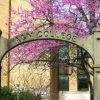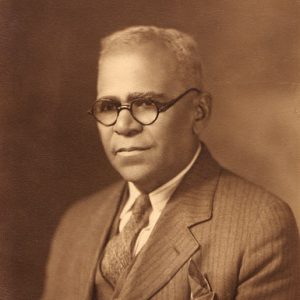calsfoundation@cals.org
John Brown Watson (1869–1942)
John Brown Watson was president of Agricultural, Mechanical, and Normal College (AM&N), now the University of Arkansas at Pine Bluff (UAPB), from 1928 until his death in 1942. Watson was a member of the first generation of African Americans born after the Civil War and representative of that demographic among his cohorts, identified as what Professor Willard B. Gatewood Jr. called “aristocrats of color.”
Watson was born near Tyler, Texas, on December 28, 1869, to Crystal and Frank Watson; he was named for the antebellum abolitionist John Brown. Educated near his home, Watson passed the county teacher examination in 1887 and taught for two years. He entered Bishop College at Marshall, Texas, in 1891 at the seventh grade level and completed his high school diploma in 1898. After teaching for two more years, Watson entered Colgate University at Hamilton, New York, in the fall of 1900. He transferred to Brown University at Providence, Rhode Island, the following year and graduated with a Bachelor of Philosophy degree in the class of 1904. Mentored by John Hope, an 1894 graduate of Brown University and the first Black president of Morehouse College and Atlanta University, Watson served as professor of mathematics and science at Morehouse College from 1904 to 1908.
On September 25, 1907, he married Hattie Louise Rutherford, a graduate of Spelman College, of Rome, Georgia. She was the elder daughter of freedman Samuel W. Rutherford, founder of the National Benefit Life Insurance Company, and Mary Anne Lemon Rutherford. In the spring of 1939, after almost thirty-two years of marriage, the Watsons adopted an infant daughter, Marian, naming her after famed contralto Marian Anderson.
In 1908, Watson left Morehouse College and, for twelve years, served as a secretary of the Colored Men’s Department of the International Committee of the Young Men’s Christian Association (YMCA). The organization’s appointment of Watson to an executive position represented a significant opportunity for his advancement to more visible careers. Watson, a graduate of an Ivy League institution and former faculty at Morehouse College, was a likely candidate for an administrative position in Black higher education in the era of segregation. He also briefly served as liquidating agent for the Atlanta State Savings Bank and as state agent for the Southern Fire Insurance Company. In 1923, he assumed the administration of Leland College (American Baptist Home Mission Society) at Baker, Louisiana.
On June 1, 1928, the State Board of Education elected Watson as president of Arkansas Agricultural, Mechanical, and Normal College at Pine Bluff (Jefferson County). The state legislature and two philanthropic agencies appropriated funds and bought a thirty-five-acre site for the institution two miles from the center of Pine Bluff. Construction began in early 1929, and students and faculty moved in before Christmas of the same year. The new physical plant consisted of eight new buildings valued at almost $600,000. Watson’s inauguration as president in the spring of 1930, at which John Hope delivered the commemorative address, enabled simultaneous dedication of the new campus site as well.
Despite the postponement of Watson’s installation ceremony, he founded and co-edited with his wife, Hattie, the college newspaper, The Arkansawyer, and the same name also christened the new college catalogue. In 1929, he attended the annual conference of the Presidents of Negro Land-Grant Colleges, the state’s first participation in more than a decade. Watson’s other initiatives included both intercollegiate athletics and an intramural sports program, debate and dramatic clubs, and free night classes for the local community. The college was reorganized with four divisions: Arts and Sciences, Agriculture, Home Economics, and Education, including a training or practice school with both elementary and secondary grades.
Watson’s administration also coincided with the Franklin Roosevelt administration’s New Deal. The college participated in the distribution of the college and graduate student funds by the Negro Division of the National Youth Administration (NYA). AM&N was the site of NYA Camp Bethune for unemployed young Black women in 1937 and for unemployed young Black men in 1940. Also in 1937, Watson donated land for what was later named Watson State Park, the first state park designated for use by African Americans; however, the state invested little in the project, and the land was eventually returned to the family. In 1938, the Works Progress Administration (WPA) funded a new library, two new dormitories, and eight brick faculty cottages.
Watson maintained membership in several professional and private organizations, including the Association of Presidents of Negro Land-Grant Colleges, Association for the Study of Negro Life and History, the National Association for the Advancement of Colored People (NAACP), Sigma Pi Phi, the Monday Club of Atlanta, the Brown University Alumni Association, and St. Paul Baptist Church at Pine Bluff.
AM&N College enrollment at the beginning of Watson’s tenure was thirty-six; the number of faculty and staff was thirty-two. At the time of United States’ entry into World War II, the college enrolled almost 500 students, employed a faculty of sixty-six, and had a physical plant valued at nearly two million dollars.
Watson died at his home on the AM&N College campus on December 6, 1942. A memorial ceremony was held at AM&N College, followed by funeral services at Sale Hall Chapel on the campus of Morehouse College. He is buried in Atlanta. The WPA library completed in 1939, Childress Hall, was dedicated and renamed in his honor in 1958; the current library, completed in 1968, is the Watson Memorial Library.
For additional information:
Chambers, Frederick. “Historical Study of Arkansas Agricultural, Mechanical, and Normal College, 1873–1943.” Ed.D. diss., Ball State University, 1970.
John Brown Watson Papers. John Hay Library Special Collections. Brown University, Providence, Rhode Island.
Teske, Steven. Unvarnished Arkansas: The Naked Truth about Nine Famous Arkansans. Little Rock: Butler Center Books, 2012.
Watson, H. R. “Arkansas’ New College.” The Crisis 37 (September 1930): 297–298, 320.
Fon Louise Gordon
University of Central Florida


 John Brown Watson
John Brown Watson 



Comments
No comments on this entry yet.